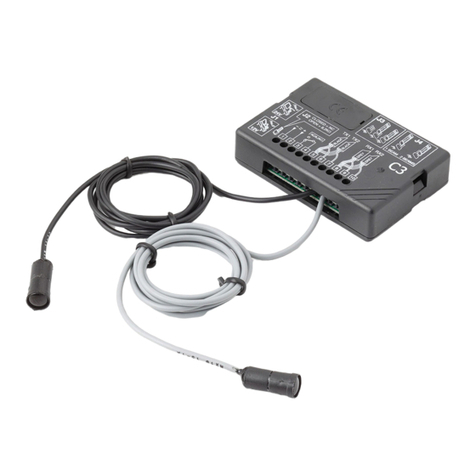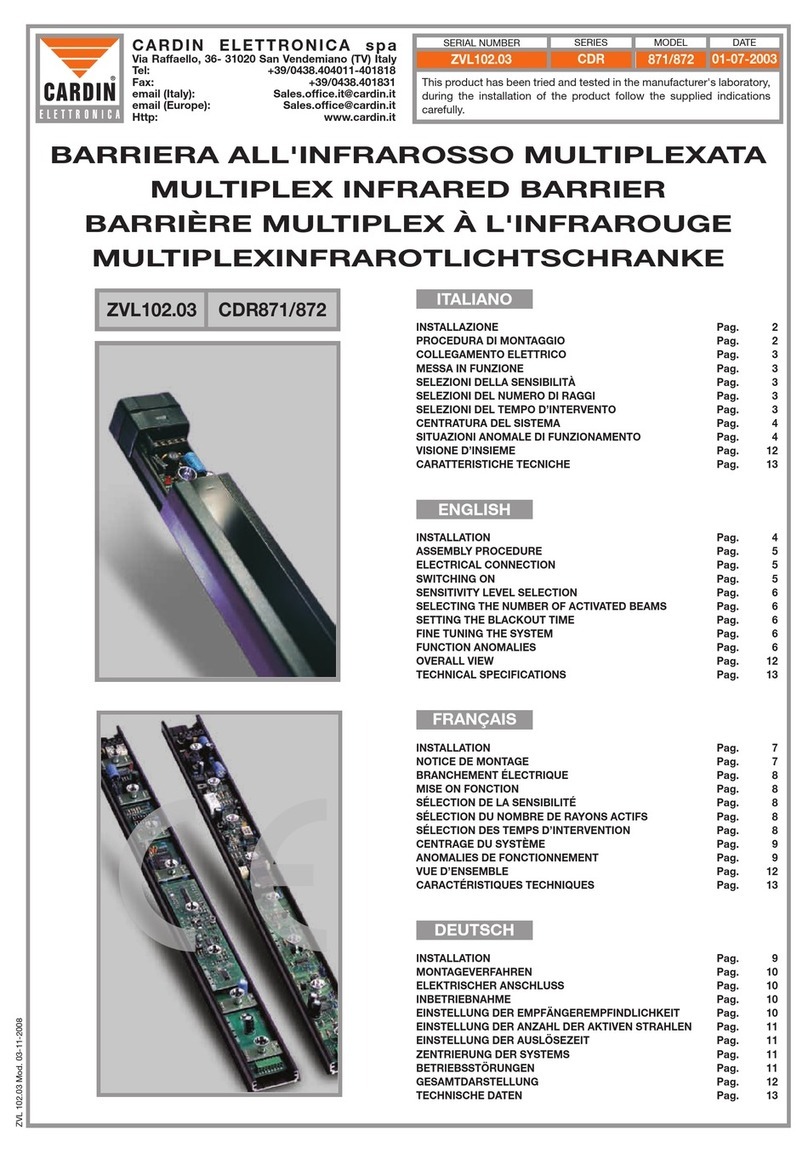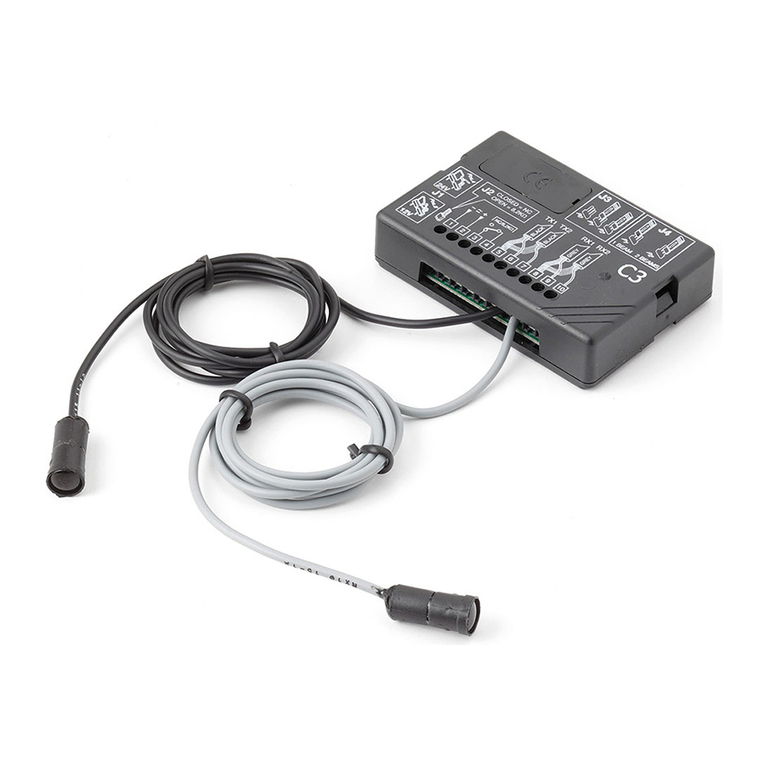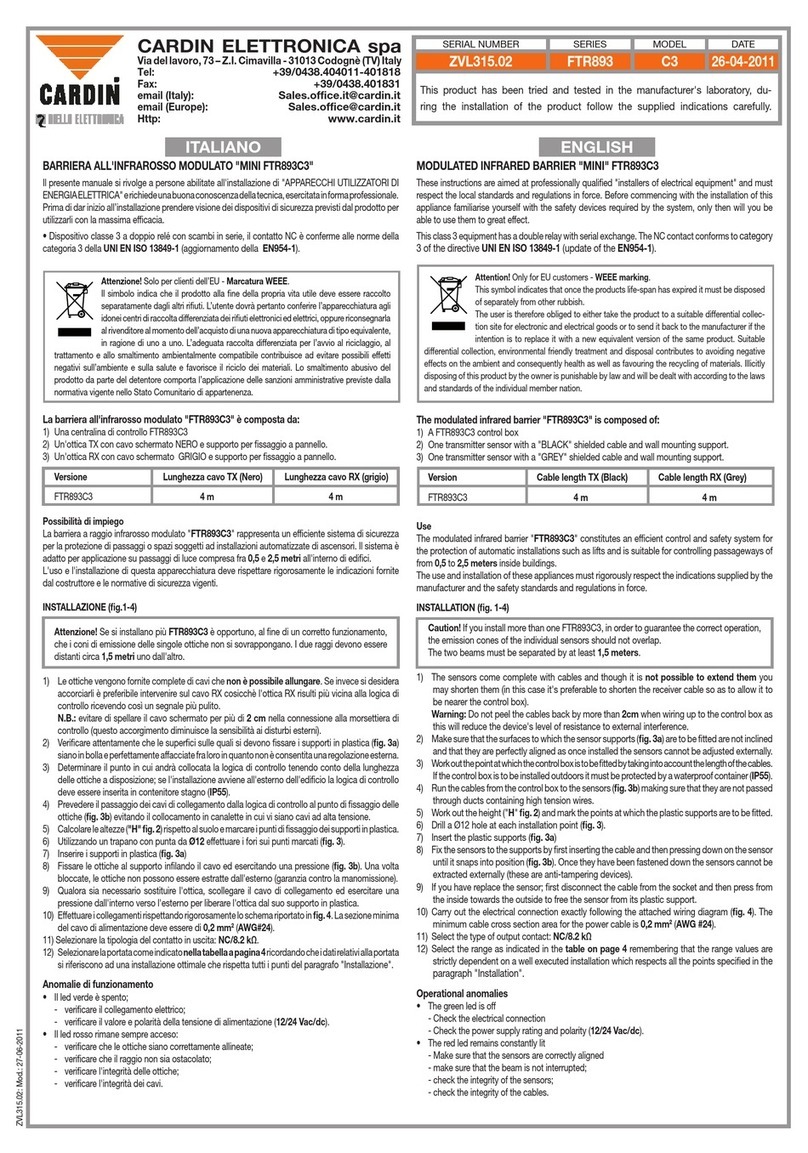
Descripción y versiones
1) La central de control CDR893
2) Zócalo para el montaje en el tablero o en la barra DIN46277
3) Un dispositivo óptico TX provistos de cable de conductores encerrados NEGRO
(3m) y soporte para la fijación en el tablero.
4) Un dispositivo óptico RX provistos de cable de conductores encerrados GRIS
(3m) y soporte para la fijación en el tablero.
Posibilidad de uso
La barrera de radiación infrarroja modulada “CDR893” representa un eficiente sistema
de seguridad para la protección de pasos o espacios sometidos a instalaciones
automatizadas de ascensores, puertas o donde se tenga que detectar el paso o la
cuenta de personas o cosas. El sistema es adecuado para la aplicación en pasos
cuya luz es de 1 a 4m.
El uso y la instalación de este aparato debe cumplir rigurosamente las indicaciones
facilitadas por el fabricante y las normas de seguridad vigentes.
N.B.: la salida está realizada por contacto sencillo no de seguridad.
Características técnicas
- Alimentación CDR: Vac-dc 10…24
- Absorción máx.: mA 60
- Temperatura de funcionamiento: °C -10…+55
- Longitud de onda de la radiación infrarroja: nm 950
- Modulación I.R. por impulsos: kHz 1.8
- Apertura del haz de emisión infrarroja: ° ±10
- Grado de protección (dispositivos ópticos): IP 55
- Tiempo de intervención relé: mS 30
- Retardo en la desexcitación: mS 100
- Mando: sencillo relé NA-NC 8A; Tensión máx. de contacto 40V ac/dc.
Alcance (véase la tabla)
INSTALACIÓN (véase fig. 1 - 4)
Cuidado:
Si se instalan varios aparatos CDR893 es oportuno, a fin de obtener su funcionamiento
correcto, que los conos de emisión de los dispositivos ópticos sencillos no se super-
pongan (los dos haces deben estar a 1 metro aproximadamente uno de otro, en las
instalaciones cuya luz de paso es de 2 metros y de 1,5 metros en caso de instalaciones
cuya luz de paso es entre 2 y 4 metros.
1) Determinar la luz de paso y elegir los dispositivos ópticos adecuados para la
instalación, recordando que los dispositivos ópticos se suministran provistos de
cables; los cables no se pueden alargar, sin embargo es posible cortarlos (en
tal caso es preferible cortar el cable RX así que el dispositivo óptico RX está más
cerca de la lógica de control).
Cuidado: No pelar más de 2 cm el cable de conductores encerrados para la
conexión en el zócalo (esto reduce la sensibilidad hacia las interferencias exte-
riores).
2) Comprobar con sumo esmero que las superficies donde se deben fijar los soportes
de plástico (fig. 2a) están llanas y perfectamente enfrentadas entre sí ya que los
dispositivos ópticos no permiten la regulación exterior.
3) Determinar el punto preciso donde se va a colocar la lógica de control teniendo
en cuenta la longitud de los dispositivos ópticos disponibles; si la instalación se
realiza al exterior del edificio, la lógica de control debe colocarse en el contenedor
estanco (IP55).
4) Disponer el paso de los cables de conexión desde la lógica de control hasta el
punto de fijación de los dispositivos ópticos (fig. 2b) sin pasarlos por los conductos
donde hay cables de alta tensión.
5) Calcular las alturas (“H” fig. 4) respecto al suelo y marcar los puntos de fijación
de los soportes de plástico.
6) Utilizando un taladro con una broca de Ø 12, realizar los agujeros en los puntos
que se acaban de marcar (fig. 2).
7) Introducir los soportes de plástico (fig. 2a).
8) Fijar los dispositivos ópticos en el soporte introduciendo el cable y ejerciendo alguna
presión (fig. 2b). Una vez bloqueados, los dispositivos ópticos no se pueden sacar
desde el exterior (garantía contra las manipulaciones).
9) De ser necesario sustituir el dispositivo óptico, desconectar el cable de conexión
y ejercer alguna presión desde el interior hacia el exterior para liberar el dispositivo
óptico de su soporte de plástico.
10)Llevar a cabo las conexiones observando rigurosamente el esquema representado
en la (fig 3). La sección mínima del cable de alimentación debe ser de 0,2 mm2
(AWG#24).
11)Seleccionar el alcance según lo indicado en la tabla a continuación
SELECCIÓN ALCANCE
* Con cualesquiera condiciones atmosféricas
Cuidado!
Los datos correspondientes al alcance se refieren a una instalación ideal que
cumple todos los puntos del párrafo "Instalación".
Funcionamiento incorrecto
• El piloto verde está apagado
- comprobar las conexiones eléctricas
- comprobar la tensión de alimentación (véase versión)
• El piloto rojo queda siempre encendido.
- los dispositivos ópticos no están alineados
- comprobar que el haz no está obstaculizado
- comprobar la integridad de los dispositivos ópticos
- comprobar la integridad de los cables
Technische Daten
- Stromversorgung: Vac/dc 10…24
- max. Stromaufnahme.: mA 60
- Betriebstemperatur: °C -10…+55
- Wellenlänge des I.R.-Lichtstrahls: nm 950
- I.R.-Impulsmodulation: kHz 1.8
- Öffnung des I.R.-Strahlungskegels: ° ±10
- Schutzgrad (Optiken): IP 55
- Relaisansprechzeit: mS 30
- Abfallverzögerung: mS 100
- Steuerung: Einzelnen relais Einschalt/-Auschaltglied-Kontakte 8A; max. Kontakt-
spannung 40V ac/dc;
Reichweite (siehe Tabelle)
INSTALLATION (siehe Abb. 1 - 4)
Achtung:
Wenn mehrere CDR893 installiert werden, dürfen sich die Strahlungskegel der einzelnen
Optiken nicht überlagern, um eine korrekte Funktionsweise zu gewährleisten. (Die
beiden Lichtstrahlen müssen einen Abstand voneinander von zirka 1 Meter haben im
Falle von Installationen mit einer Torweite von 2 Metern und 1,5 Metern im Falle von
Installationen mit einer Torweite zwischen 2 Metern und 4 Metern.
1) Bestimmen Sie die Torweite und wählen Sie die zur Installation geeigneten Op-
tiken, wobei Sie sich daran erinnern sollten, dass die Optiken komplett mit ihren
Kabeln geliefert werden; ein Verlängern der Kabel ist nicht möglich; sie können
aber verkürzt werden (in diesem Fall ist die Verkürzung des Empfänger Kabels RX
vorzuziehen, so dass die Empfänger-Optik RX näher zur Kontrollogik kommt).
Achtung: Vermeiden Sie, das abgeschirmte Kabel auf mehr als 2 cm beim
Anschluss auf dem sockel abzuisolieren (dies verringert die Empfänglichkeit
gegenüber Störungen von außen).
2) Prüfen Sie aufmerksam, ob die Oberflächen, auf denen die Plastikhalter befestigt
werden sollen (Abb. 2a), waagerecht sind und sich perfekt gegenüberliegen, da
die Optiken nicht von außen eingestellt werden können.
3) Bestimmen Sie die Stelle, an der die Kontrollogik untergebracht werden soll,
wobei Sie sich die Kabellänge der zu Verfügung stehenden Optiken vor Augen
halten sollten. Wenn die Installation außerhalb des Gebäudes erfolgt, muss die
Kontrollogik in einem wetterdichten Gehäuse (IP55) untergebracht werden.
4) Bereiten Sie den Verlauf der Verbindungskabel von der Kontollogik bis zur
Befestigungsstelle der Optiken (Abb. 2b) vor, wobei das Zusammenlegen mit
Starkstromkabeln in den Kabelkanälen vermieden werden sollte.
5) Berechnen Sie die Höhen vom Boden (“H” Abb. 4) und markieren Sie die Befes-
tigungspunkte der Plastikhalter.
6) Mit einem Bohrer, der mit einer Bohrspitze Ø 12 ausgestattet ist, bohren Sie die
Löscher an den markierten Punkten (Abb.2).
7) Setzen Sie die Plastikhalter ein (Abb. 2a).
8) Befestigen Sie die Optiken am Träger, indem Sie das Kabel einführen und Druck
ausüben (Abb. 2b). Nachdem die Optiken befestigt sind, können sie von außen
nicht mehr herausgezogen werden (Garantie gegen Mißgriffe).
9) Falls eine Ersetzung der Optik notwendig werden sollte, lösen Sie das Verbin-
dungskabel und üben Sie Druck von innen nach außen aus, um die Optik aus ihrer
Plastikhalterung zu befreien.
10) Führen Sie die Anschlüsse aus, wobei Sie rigoros das in der (Abb. 3) wiedergeg-
ebene Schema befolgen. Der Durchmesser des Stromversorgungskabels sollte
mindestens 0,2 mm2betragen (AWG#24).
11) Wählen Sie die Reichweite wie es in der nachstehenden Tabelle angegeben ist:
AUSWAHL DER REICHWEITE
* Bei jeder Witterung
Achtung!
Die Reichweite betreffenden Daten beziehen sich auf eine optimale Installation,
bei der alle Punkte des Abschnittes "Installation" beachtet worden sind.
Betriebsstörungen
• Die grüne Led leuchtet nicht.
- Überprüfen Sie den elektrischen Anschluss.
- Überprüfen Sie die Spannung der Stromversorgung (Seihe Versionen)
• Die rote Led leuchtet dauernd.
- Die Optiken sind nicht ausgerichtet
- Überprüfen Sie, ob der Lichtstrahl behindert wird.
- Überprüfen Sie die Unversehrtheit der Optiken.
- Überprüfen Sie die Unversehrtheit der Kabel.
POSITION INTERNE REICHWEITE EXTERNE REICHWEITE*
WAHLSCHALTER max. min.
Pos. 1 1 0,5
Pos. 2 2 1
Pos. 3 4 2
BARRERA AL INFRARROJO MODULADO “MINI CDR893”
ADVERTENCIAS
Antes de dar inicio a la instalación, léase con esmero este manual.
En especial, véase los dispositivos de seguridad dispuestos para el producto para
poderlos utilizar con la máxima eficacia. Este manual se dirige a personas habilitadas
para la instalación de “aparatos utilizadores de energía eléctrica” y exige el buen
conocimiento de la técnica, realizada profesionalmente.
ESPAÑOL
POSICION ALCANCE INTERIOR ALCANCE EXTERIOR*
SELECTOR max. min.
Pos. 1 1 0,5
Pos. 2 2 1
Pos. 3 4 2



























